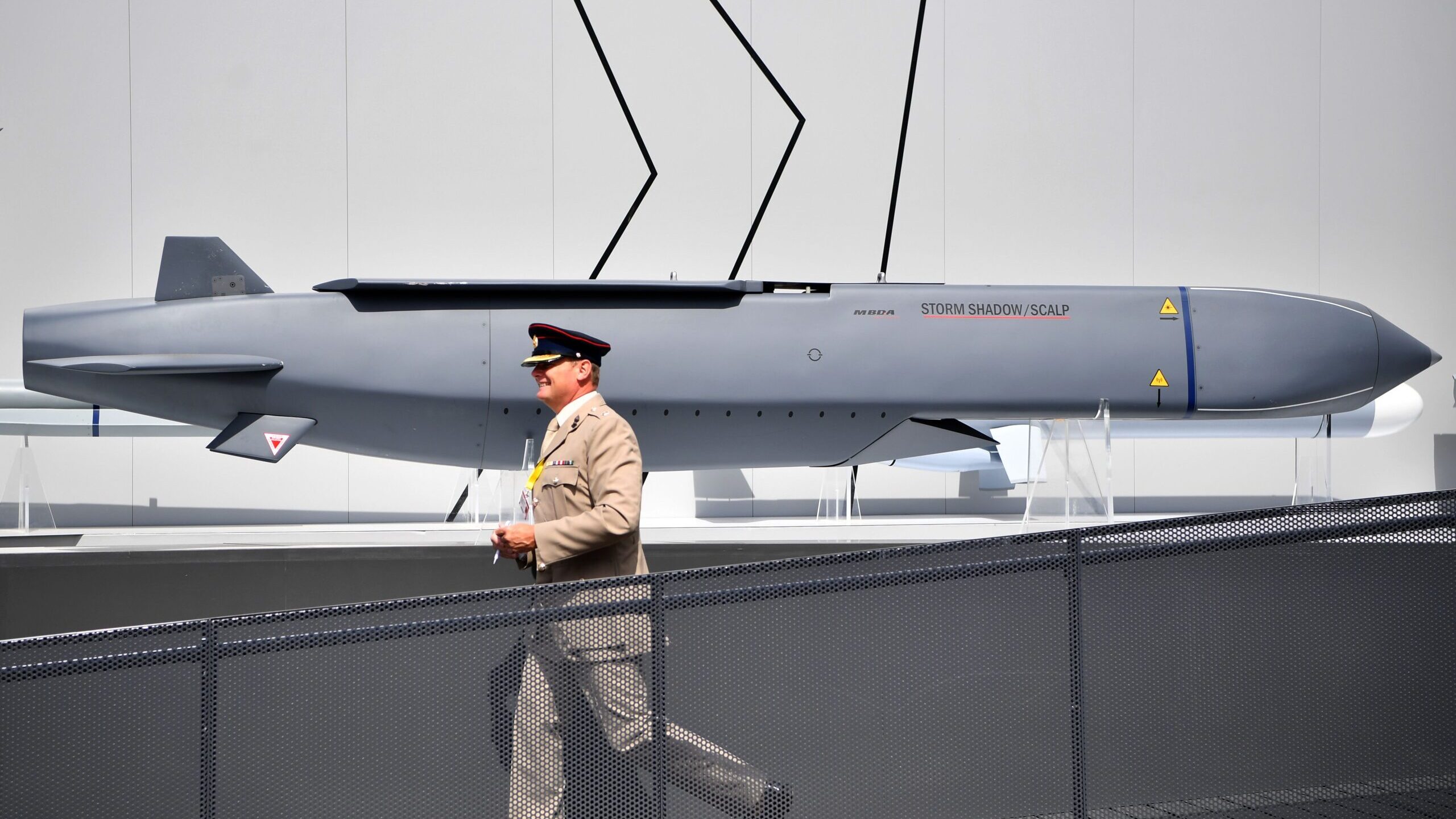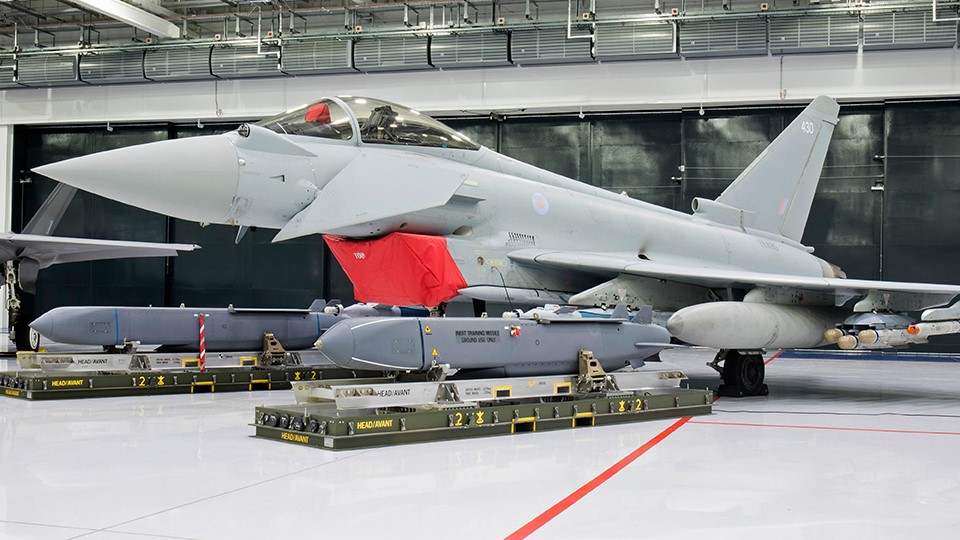AARON MEHTA and REUBEN JOHNSON
 WASHINGTON and FT. LAUDERDALE, Fla. — The UK’s decision to arm Ukraine with the long-range Storm Shadow missile could serve as a game changer, with a top British officer telling Breaking Defense the weapon will be especially valuable in taking out sites vital for Russia’s logistics.
WASHINGTON and FT. LAUDERDALE, Fla. — The UK’s decision to arm Ukraine with the long-range Storm Shadow missile could serve as a game changer, with a top British officer telling Breaking Defense the weapon will be especially valuable in taking out sites vital for Russia’s logistics.However, questions remain, including whether Ukraine is operating under restrictions with the weapon, how many weapons are being shipped to Kyiv’s aid, and what platforms might actually be used to deliver the weapons onto Russian forces.
On May 11, UK MoD confirmed several days’ worth of rumors that London would be providing the air-launched, MBDA-made Storm Shadow to Ukraine. Defence Secretary Ben Wallace announced to parliament that the long-range missiles “are now going into, or are in, the country itself.”
Storm Shadow’s 155-mile range more than triples the reach of the longest-range weapon provided thus far from the US as part of the HIMARS rocket artillery system. It plugs a clear gap in Ukraine’s capability for the kind of strike weapon that would enable Ukrainian forces to hit Russian command posts deep inside Crimea.
“These missiles will help them to hit the command-and-control nodes, the logistics, where you have a sort of coalescence of Russian soldiers,” Rear Admiral Tim Woods told Breaking Defense in a Monday interview. “And what that means is, you are much better able to starve the front line of direction, logistics, weapons and people. And so yeah, it’s critical that we have something with this range. Because you know, that enables them to sort of fight that deep battle better.”
Woods serves as the Defence Attache at the British embassy in Washington, making him a key interlocutor for the “special relationship” between the UK and US. But he also carries significant first-hand knowledge of the Ukraine conflict, having served as the military attaché to Kyiv directly before this posting — a term that overlapped with Russia’s invasion.
“I’ve stood on Kramatorsk station, which the Russians have now hit … I’ve been to Bakhmut, and it does break my heart to see the fact that in Bakhmut, there were 70,000 people when I went there, there’s now 7,000 people that have been living for nine months, without clean water, without electricity, hiding in cellars and basements,” he said. “So every time we’ve provided a piece of equipment, it’s been so that Ukraine can defend itself better. And so the idea of these long range missiles is that they can fight the deep battle better.”
In December 2022 Wallace admonished the Russian Defence Minister, Sergei Shoigu, that continuing to attack non-military targets could convince the UK to donate more advanced weapons to Ukraine. Two months later, UK Prime Minister Rishi Sunak echoed this warning, stating “together we must help Ukraine to shield its cities from Russian bombs and Iranian drones. That’s why the United Kingdom will be the first country to give Ukraine longer-range weapons.”
In Wallace’s May 11 address to the House of Commons, he characterized the decision as “calibrated and proportionate to Russia’s escalations. None of this would have been necessary had Russia not invaded [Ukraine],” he added. (Former MoD officials also tell Breaking Defense that Wallace has been seeking to assume a higher profile in support for Ukraine as part of his aspirations to become the next NATO Secretary General.)
Woods, echoed those comments, noting that the Russians shouldn’t be taken by surprise: “Our embassy in Moscow notified them of the intention to provide Ukraine with this capability. And we made it very clear to the Russians, and why we did that, you know — they could end this war anytime they want.”
Delivery Options Up In The Air
Storm Shadow is one of several projects to result from the creation of MBDA, an Anglo-French defense industrial alliance. In French the missile is designated SCALP EG (Système de Croisière Autonome à Longue Portée — Emploi Général). The weapon’s design is a modification of the French Apache air-launched cruise missile — achieved by substituting the original cluster munitions package with a nearly 1,000 pound warhead.
Since Ukraine has yet to receive any Western fighter aircraft, there is an open question of what platform Storm Shadow will be launched from. Integration of Western weapons onto Russian-design aircraft operated by the Ukrainian Air Force (PSU) has become almost a standard practice. Since the war began, both the US Boeing Joint Direct Attack Munition (JDAM) and the Raytheon AGM-88 HARM anti-radiation missile have been integrated and launched from the Mikoyan MiG-29 aircraft in Ukraine inventory.
While declining to go into operational specifics about what platform could be used, Woods noted that “Ukraine surprised just about everyone on their ability to incorporate these weapons systems in novel ways, and they’re very quick learners.
“So it would not surprise me if these weapons could be integrated onto one of their existing platforms. And you know, they’ve still got some capable platforms, whether it’s the Sukhoi 24s, or Mig-29s — they have shown the innovative and ingenuity to be able to do so. So I think we’re pretty comfortable. And we would not have given Storm Shadow if they couldn’t be used.”
The Sukhoi Su-24M Fencer fighter-bomber, comparable in size to the now-retired US General Dynamics F-111, might be the most likely option. Ukraine was left with a large number of these aircraft after the collapse of the USSR and has been refurbishing older air frames, cannibalizing those which are no longer flyable and bringing new aircraft into inventory literally faster than the Russian Aerospace Force (VKS) and air defense units can shoot them down.
US and other western defense industry officials familiar with the Storm Shadow design feel confident the Su-24 could work with Storm Shadow. One industry source told Breaking Defense that “provided there are no aerodynamic issues involved in the separation of the missile from the [Sukhoi] air frame, the missile could easily be launched from this platform.”
After release from the aircraft, the missile drops to low altitude to avoid air defense radar networks. Weapons like Storm Shadow then “use an imaging IR seeker in terminal phase that compares what it ‘sees’ as it approaches the target coordinates with satellite or ISR platform-produced imagery of the target site itself that was uploaded to the missile on the ground,” the industry source explained. “If what the seeker is viewing and the imagery ‘match’ then the missile commits to its final phase and strikes its target.”
“Therefore, the aircraft’s main mission computer (MMC) being able to ‘talk’ to the missile is less of an issue with a long-range weapon like the Storm Shadow than it is with shorter range tactical munitions due to the targeting data being programmed into the missile before take-off,” he continued.
A Bridge Not Too Far
The central concern of the US and its allies is that if Ukraine were provided longer-range weapons, they would be used to hit targets inside of Russia — provoking an escalatory response from Putin. This had prompted the Ukrainian Defence Minister, Oleksii Reznikov, to provide assurances earlier this year that any longer-range missiles would not be used in this manner.
“Ukraine is ready to provide any guarantees that your weapons will not be involved in attacks on the Russian territory,” he said. “But if we could strike at a distance of up to 300 kilometers, the Russian army wouldn’t be able to provide defense and will have to lose,” he said at an EU forum.

The Storm Shadow has been the UK’s main air-launched cruise missile for decades. (UK MoD)
Reznikov’s “have to lose” comment refers to the Ukraine battle plan to strike strategic targets in Crimea that would make it impossible for Russia to continue its military presence there. Those targets are well within Storm Shadow’s operational range — assuming there are not restrictions placed on the weapon itself, either by political or technical means, in order to make sure the Ukrainians don’t hit Russia proper.
Woods did, however, make one thing clear: As far as the UK is concerned, “Crimea Is Ukraine … It is Ukrainian territory at the end of the day.”
So, what targets will be held at risk with the new weapon? If you are Ukraine “you start hitting targets to make the peninsula untenable for Russian forces,” said Ben Hodges, a retired US Army Lt. Gen. and former US European Command chief, in a late April interview with Newsweek.
“If the Ukrainians had the ATACMS, for example, the Black Sea Fleet would have already had to leave Sevastopol, they would have been hitting that place already,” he explained. “You hit Sevastopol and the Black Sea Fleet has to leave, they can’t sit there while precision weapons are raining down on ships, or harbor facilities, fuel, ammo, etc. Same thing with the [naval aviation] airbase in Saki.”
One of the main targets for the Storm Shadow is likely to be the bridge over the Kerch Straits that was originally damaged in an attack by the Ukrainian military in October 2022.
The bridge was constructed to connect Crimea with the Russian mainland after Moscow’s illegal invasion and annexation of this Ukrainian region in March 2014 and has also been a personal vanity project of Putin. Timing the attack in tandem with his birthday reportedly enraged the Russian leader.
Hodges projects that at first the Ukrainians “will not drop that bridge. “I think they’ll leave it up so that people can leave, so they literally have a bridge to get out of there if they see what’s happening, and they don’t want to remain under Ukrainian control.”
A former US military official told Breaking Defense that there are “psychological [warfare] benefits to keeping the bridge intact. A rush of people and vehicles to flee across the bridge adds to the ‘panic’ factor that Ukraine hopes will set in after their major counteroffensive expected within the next month.”
“At some point the Ukrainians will drop it [the bridge],” echoed Hodges in the same interview. “But in the near term, I think they’ll probably leave it up, unless the Russians are using it in a meaningful way after the land bridge has been cut. If they’re pouring in a lot more capabilities over the Kerch Bridge [back into Crimea], then they may decide to drop it.”
Ultimately, Woods said, he trusts the Ukrainians to use the weapons where they will do the most damage to Russian operations.
“With the other weapons systems [Ukraine has] actually used them responsibly. So they have never hit civilian targets, they’ve only hit military targets. And they have been using these weapon systems within their own territory. They’re all being used as part of expelling Russia’s illegal invasion … They will be using the weapon systems as they need to fight that deep battle.
No comments:
Post a Comment